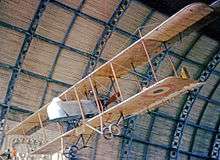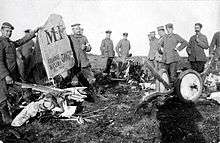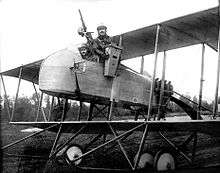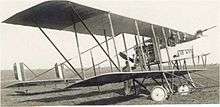Farman MF.11
| MF.11 | |
|---|---|
 | |
| Role | Reconnaissance / Light Bomber |
| Manufacturer | Farman Aviation Works |
| Designer | Maurice Farman |
| First flight | 1913 |
| Introduction | May 1914 |
| Primary users | French Air Force Royal Flying Corps |
The Maurice Farman MF.11 Shorthorn is a French aircraft developed before World War I by the Farman Aviation Works. It was used as a reconnaissance and light bomber during the early part of World War I, later being relegated to training duties.
The Maurice Farman Shorthorn was the aircraft in which Biggles, Capt W.E. Johns' fictional character, first took to the air in "Biggles Learns To Fly".
Design and development
A pusher configuration unequal-span biplane like the earlier Farman MF.7, the MF.11 differed in lacking the forward-mounted elevator, the replacement of the biplane horizontal tail surfaces with a single surface with a pair of rudders mounted above it, and the mounting of the nacelle containing crew and engine in the gap between the two wings. The aircraft was also fitted with a machine gun for the observer, whose position was changed from the rear seat to the front in order to give a clear field of fire.
Its name derived from that of the MF.7 Longhorn, as it lacked the characteristic front-mounted elevator and elongated skids of its predecessor.
Operational history


On 6 September 1914 the first air-sea battle in history took place when a Japanese Farman MF.11 aircraft launched by the seaplane carrier Wakamiya unsuccessfully attacked SMS Kaiserin Elisabeth with bombs.[2]
The MF.11 served in both the British and French air services on the Western Front in the early stages of the war. As a light bomber it flew the first bombing raid of the war when on 21 December 1914 an MF.11 of the Royal Naval Air Service attacked German artillery positions around Ostend, Belgium.
The MF.11 was withdrawn from front-line service on the Western Front in 1915, but continued to be used by the French in Macedonia and the Middle East, while the British also used it in the Dardanelles, and Africa. The Australian Flying Corps (AFC), provided with the MF.11 by the British Indian Army, operated it during the Mesopotamian campaign of 1915–16.
Italy's Società Italiana Aviazione, a Fiat company, licence-built a number of MF.11s under the designation SIA 5 from early 1915, fitted with a fixed forward machine gun and a 74.5 kW (100 hp) Fiat A.10 engine.[3]
In 1916, the AFC also bought some MF.11s for training purposes.


Operators
- Australian Flying Corps
- No. 5 (Training) Squadron AFC in United Kingdom
- Mesopotamian Half Flight
- Central Flying School AFC at Point Cook, Victoria
- Royal Saudi Air Force - Two Farman MF.11s were obtained from Italy in 1921.
- Ukrainian Air Force - One aircraft only.
Survivors
- The Canada Aviation Museum has an MF.11 manufactured by Airco for the Royal Flying Corps and sent to Australia in 1916.
- Farman F.11A-2, Royal Army and Military History Museum, Brussels, Belgium.
- Farman MF.11 Shorthorn (#CFS-15), RAAF Museum at Point Cook, Victoria, Australia.
Specifications (MF.11)
Data from Encyclopedia of Military Aircraft[4]
General characteristics
- Crew: Two (pilot & observer/gunner)
- Length: 9.45 m (31 ft 0 in)
- Wingspan: 16.15 m (53 ft 0 in)
- Height: 3.18 m (10 ft 5 in)
- Wing area: 57.00 m² (613 ft²)
- Empty weight: 550 kg (1,210 lb)
- Loaded weight: 928 kg (2,045 lb)
- Powerplant: 1 × Renault 8-cylinder air-cooled inline engine, 75 kW (100 hp)
Performance
- Maximum speed: 106 km/h (57 knots, 66 mph) at sea level
- Service ceiling: 3,800 m (12,467 ft)
- Endurance: 3.75 hours
Armament
- Guns: 1 × 7.62 mm (0.30 in) machine gun
- Bombs: 18 × 7.3 kg (16 lb) bombs
See also
Related development
Related lists
References
- ↑ The Aerodrome Forum]
- ↑ Donko, Wilhelm M.: „Österreichs Kriegsmarine in Fernost: Alle Fahrten von Schiffen der k.(u.)k. Kriegsmarine nach Ostasien, Australien und Ozeanien von 1820 bis 1914“ (epubli, Berlin, 2013) - Page 4, 156-162, 427.
- ↑ Taylor, Michael J H. Jane's Encyclopedia of Aviation. pg 805. Portland House, 1989. ISBN 0-517-69186-8
- ↑ Jackson, Robert, The Encyclopedia of Military Aircraft, Paragon, 2002. ISBN 0-7525-8130-9
External links
| Wikimedia Commons has media related to Farman MF.11. |